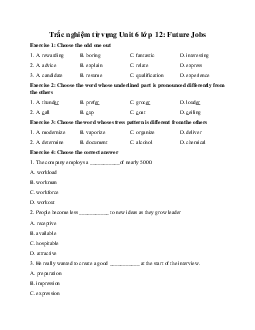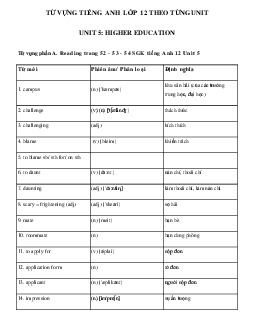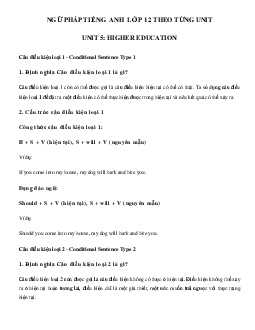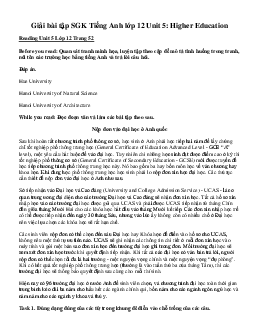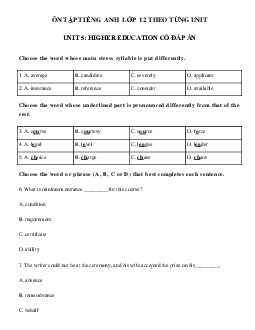









Preview text:
Pronunciation - trang 33 Unit 5 Sách Bài Tập (SBT) Tiếng anh 12 mới
Read aloud the following sentences twice, paying special attention to the underlined sounds. First,
say them slowly, carefully pronouncing each sound; then say them quickly connecting the final
and initial sounds of words. What assimilation changes did you notice?
Đọc to những câu sau đây hai lần, đặc biệt chú ý đến những âm thanh được gạch dưới. Đầu tiên, nói từ
từ, cẩn thận phát âm từng âm thanh; sau đó nói chúng nhanh chóng kết nối với những âm thanh cuối
cùng và bắt đầu của các từ. bạn đã nhận thấy sự đồng hoá thay đổi những gì? 1.
Asian cultures are still being studied widely in Western countries. 2.
Pass your book to me when you have finished reading it. 3.
Could you tell me what makes you so certain? 4.
The cheese shop on the corner of the road should be closed by this time. 5.
The action plan for getting more sales is still under debate. 6. My father can cook very wel. 7.
I’d like a piece of the sweet cake. 8.
My older brother still behaves like a five-year-old boy. Đáp án:
Vocabulary & Grammar - trang 34 Unit 5 Sách Bài Tập (SBT) Tiếng anh 12 mới
1. Complete the following sentences with the words in the box. (Hoàn thành các câu sau đây với các từ trong hộp.)
assimilation celebrated cultural culture preserve solidarity
identity immigrants multicultural national pride 1.
Children of __________ may find it difficult to form their cultural identity. 2.
People going to study or work overseas for the first time might experience __________ shock to some degree. 3.
Some workers may have specific __________ needs or requirements, which employers should take into account. 4.
The university students expressed their __________ with the factory workers, who demanded
higher pay and better working conditions. 5.
The Japanese New Year has been ___________ on January 1 of each year since 1873. 6.
Critics say the new policy has resulted in complete cultural of non-English speaking immigrants. 7.
Her success as the world chess champion is a source of __________ . 8.
In __________ societies, people are encouraged to maintain their heritage languages and traditions. 9.
The organisation is helping Native American tribes to __________ their culture and language. 10.
Remember that things such as language, food and clothing are simply expressions of our cultural __________. Đáp án:
1. immigrants 2. culture 3. cultural 4. solidarity
5. celebrated 6. assimilation 7. national pride 8. multicultural 9. preserve 10. identity Dịch: 1.
Trẻ em của những người nhập cư có thể thấy khó khăn để hình thành bản sắc văn hóa của họ. 2.
Những người đi du học hoặc làm việc ở nước ngoài lần đầu tiên có thể gặp cú sốc văn
hóa đến một mức độ. 3.
Một số công nhân có thể có nhu cầu văn hóa cụ thể hoặc yêu cầu, điều mà chủ lao động nên cân nhắc. 4.
sinh viên đại học đã bày tỏ tình đoàn kết với các công nhân nhà máy, người yêu cầu mức lương
cao hơn và điều kiện làm việc tốt hơn. 5.
Năm mới của Nhật Bản đã được tổ chức vào ngày 1 tháng 1 của mỗi năm kể từ năm 1873. 6.
Những người chỉ trích nói rằng chính sách mới đã dẫn đến sự đồng hoá văn hóa hoàn toàn
của những người nhập cư không nói tiếng Anh. 7.
thành công của cô như là nhà vô địch cờ vua thế giới là một niềm tự hào quốc gia. 8.
Trong các xã hội đa văn hóa, người dân được khuyến khích để duy trì ngôn ngữ di sản và truyền thống của họ. 9.
tổ chức đang giúp đỡ các bộ lạc người Mỹ bản địa để bảo tồn văn hóa và ngôn ngữ của họ. 10.
Hãy nhớ rằng những thứ như ngôn ngữ, thực phẩm và quần áo là những biểu hiện đơn
giản của bản sắc văn hóa của chúng ta.
2. Each of the following sentences has ONE mistake in tense. Make the corrections and write the
correct sentences in the spaces provided. (Mỗi câu sau đây có MỘT lỗi ở thì. Thực hiện những điều
chỉnh và viết câu đúng trong chỗ được cung cấp.) Example (Ví dụ)
During the first week on campus, we have felt excited and happy, but later on we began to find the new
life frustrating in many ways.
=> During the first week on campus, we felt excited and happy, but later on we began to find the new
life frustrating in many ways.
1. - Have you ever been working in a place where your colleagues are from diverse cultural backgrounds?
-I have, and I found it a challenge.
2. I have done this English course for three months only and I am expected to make quick progress in the rest of the programme.
3. I have tried many trad tionat dishes on the numerous overseas trips I make for the past five years.
4. My grandparents lived in this country for 30 years, but they still keep thinking about their home country.
5. The family have armed last month and they will need some time to get used to their new environment. Đáp án:
1. - Have you ever worked in a place where your colleagues are from diverse cultural backgrounds?
- I have, and I found it a challenge.
2. I have been doing this English course for three months only and I am expected to make quick progress in the rest of the programme.
3. I have tried many traditional dishes on the numerous overseas trips I have made for the past five years.
4. My grandparents have lived/have been living in this country for 30 years, but they still keep thinking about their home country.
5. The family arrived last month and they will need some time to get used to their new environment. Dịch:
1. - Bạn đã từng làm việc ở một nơi mà đồng nghiệp của bạn là từ các nền văn hóa đa dạng chưa?
- Tôi từng, và tôi thấy nó là một thách thức.
2. Tôi đã học khóa học tiếng Anh này chỉ ba tháng và tôi đang dự kiến sẽ tiến bộ nhanh chóng trong
phần còn lại của chương trình.
3. Tôi đã thử nhiều món ăn truyền thống trên nhiều chuyến đi nước ngoài tôi đã thực hiện trong năm năm qua.
4. Ông bà của tôi đã sống ở đất nước này trong 30 năm, nhưng họ vẫn tiếp tục suy nghĩ về đất nước của họ.
5. gia đình đến vào tháng trước và họ sẽ cần một số thời gian để quen với môi trường mới.
3 Use the words provided to write a second sentence so that it follows on from the first one. Use
repeated comparatives as shown in the example. (Sử dụng những từ được cung cấp để viết một
câu thứ hai để nó theo ngay sau từ đầu tiên. Sử dụng lặp đi lặp lại số liệu so sánh như thể hiện trong ví dụ.) Example (Ví dụ)
Buy 2 items and get 20% off; buy 3 items and get 30% off; buy 5 items at half-price.This does not mean
that___________________________ ? Utems/become/better/priced)
=> This does not mean that items are becoming better and better priced.
1. As she travelled to move places, she started to appreciate her hometown's beauty. In other words,
___________________________ . (hometown / seemed /more/ beautiful / mind)
2. Online communication is becoming more and more common.
The problem is that _______________________ . (few/people /interact/ face to face)
3. The Vietnamese ao dai has been modernised. In fact, ____________________________ . (become
/popular/not only/Viet Nam/but/other parts world) 4. Globalisation is endangering peoples unique cultural identities. In this trend,
_______________________ . (differences /cultural values /become/important)
5. Most people are highly devoted to the values of the community they come from. However,
___________________ . (they/also /become/sympathetic /other/cultures /beliefs) Đáp án: 1.
her hometown seemed more and more beautiful in her mind 2.
fewer and fewer people are interacting face to face 3.
it is becoming more and more popular not only in Viet Nam, but in other parts of the world 4.
differences in cultural values become/are becoming less and less important 5.
they are also becoming more and more sympathetic to other cultures and beliefs Dịch:
1. quê hương của cô dường như ngày càng đẹp hơn trong tâm trí cô
2. ngày càng ít người tương tác trực tiếp
3. nó đang trở nên ngày càng phổ biến không chỉ ở Việt Nam, mà ở các phần khác của thế giới
4. khác biệt về giá trị văn hóa trở nên / đang trở nên ngày càng ít quan trọng hơn
5. họ cũng đang ngày càng trở nên đồng cảm hơn với các nền văn hóa và tín ngưỡng khác
Reading - trang 36 Unit 5 Sách Bài Tập (SBT) Tiếng anh 12 mới
1. Read the following text and fill each gap with a word from the box. (Đọc đoạn văn dưới đây và
điền vào mỗi chỗ trống với một từ trong hộp)
ancestors controversial superstition rituals
generations authorities proud expressions
While people's cultural identity is undoubtedly always protected and regarded as their most
important characteristic, its (1) _________ can sometimes be inappropriate, particularly in today's
modern society. In the age of increased globalisation, some festivals include (2) _________ that are
considered too old-fashioned and obviously need to be modified.
An example is the (3) ___________ pig-slaughter festival in a village in northern Viet Nam.There has
been outrage in the country and other parts of the world as shocking photos and videos have shown the
pigs getting tied down and sliced in half. According to ancient beliefs, this festival is celebrated to pray
for good luck and fortune in the new year.
The pig-slaughter ceremony has taken place in the village for many centuries.The older (4) _________
insist on continuing this so-called ‘cultural’ practice and have argued that they are keeping the traditions
of their (5)__________________ alive. They also say it does not break the law and should be decided by the villagers.
Concerns about this backward festival have been raised not only by international animal rights groups,
but also by the (6) _________.They have called on villagers to make certain adjustments to the
ceremony. A government spokesperson has also expressed disapproval of cultural practices that are
based on (7) _________ and barbarian practices.
Ultimately, traditions will have to undergo changes as societies become more modern and develop new
values and symbols. While it is important to preserve traditions and customs, communities should make
sure that the rituals are in harmony with current social beliefs, strengthen their sense of belonging, and
make people (8) _________of their cultural identity. Đáp án:
1. expressions 2. rituals 3. controversial 4. generations
5. ancestors 6. authorities 7. superstition 8. proud
2 Does the writer approve or disapprove of the pig-slaughter festival? Find the words/phrases
in the text that indicate his attitude towards the ritual. (nhà văn chấp thuận hay không chấp thuận lễ
hội giết mổ lợn? Tìm các từ / cụm từ trong văn bản mà chỉ ra thái độ của anh đối với các nghi lễ.)
Paragraph 1: ____________________________
Paragraph 2: ____________________________
Paragraph 3: ____________________________
Paragraph 4: ____________________________ Đáp án:
Paragraph 1. inappropriate; old-fashioned
không thích hợp; Cổ hủ
Paragraph 2. controversial; outrage; shocking
gây tranh cãi; phẫn nộ; gây shock
Paragraph 3. so-called ‘cultural’ cái gọi là 'văn hóa'
Paragraph 4. concerns; backward; disapproval; superstition; barbarian
mối quan tâm; lạc hậu; không chấp thuận; mê tín dị đoan; dã man
3. Based on the information in the text, complete the following sentences with no more than four
words. (Căn cứ vào các thông tin trong văn bản, hoàn thành các câu sau đây với không quá bốn từ.) 1.
As Viet Nam is becoming part of the international community, it is important that its festivals not include any _______________. 2.
There are two arguments in favour of the pig-slaughter festival: it maintains an age-old tradition and does not _______________ 3.
The event has been criticised by the authorities and ____________. 4.
The government have expressed their negative opinion of customs that are based on _______________. 5.
The writer thinks that people should only preserve rituals that are in line with current social
beliefs and build up _______________. Đáp án: 1.
backward/inappropriate rituals: Khi Việt Nam đang trở thành một phần của cộng đồng quốc
tế, quan trọng là lễ hội của nó không bao gồm bất kỳ nghi thức lạc hậu/không phù hợp 2.
break the law: Có hai lập luận ủng hộ lễ hội giết mổ lợn : nó duy trì một truyền thống lâu đời và không vi phạm pháp luật 3.
international animal rights groups: Sự kiện đã bị chỉ trích bởi các nhà chức trách và các
nhóm quyền lợi động vật quốc tế 4.
superstition and barbarian practices: Chính phủ đã bày tỏ quan điểm tiêu cực của họ về phong
tục dựa trên sự mê tín và thông lệ dã man 5.
their sense of belonging: nhà văn cho rằng mọi người chỉ nên duy trì các nghi lễ mà phù hợp
với niềm tin của xã hội hiện nay và xây dựng ý thức về của cải của họ
Speaking - trang 38 Unit 5 Sách bài tập (SBT) Tiếng anh 12 mới
1. Choose the utterances (a-f) to complete the conversation. (Chọn những phát biểu (a-f) để hoàn thành cuộc trò chuyện.)
a. maintain my cultural identity b. but they won't last long
c. you can wear your traditional dress
d I'm worried about culture shock
e there are some styles of clothing associated with Australia
f. should be encouraged to wear their national costumes
Vy: I'm going to study in Australia and (1)____________.What should I do?
David: Well, Australians are very friendly people and you can make lots of friends. That would help.
Vy: But I'll miss my mum's cooking. Do you think I should take my favourite Vietnamese snacks with me?
David: (laughing) Yes, of course, (2)___________Australia is a multicultural country and you'll be able
to find some nice Vietnamese restaurants there. You should also try to speak more English and experience the new culture.
Vy: Yes, but I want to (3) ___________.
David: I'm sure that you can do that. Obviously, you can't speak Vietnamese, except when you're with
your Vietnamese friends, but (4)_____________. It's that long silk dress, isn't it?
Vy: You mean the ao dai? We used to wear the plain white ao dai as school uniforms. I also have some
ao dai that I wear at Tet and on other formal occasions. I love ther' definitely take them with me.
David: The ao dai is very beautiful. I think people (5)___________ . We car earn a lot about the history,
culture and customs of a country from its traditional clothing.
Vy: I agree. Do you have a national costume in Australia?
David: No, we don't have an official national costume, but (6)___________ for example, bushwear is
basically clothes that are worn when you go into the forests and surSvear is anything you wear on the beach.
Vy: Sounds interesting and so different from Viet Nam! Đáp án: 1. d 2. b 3. a 4.c 5.f 6. e Dịch:
Vy: Tôi đang đi du học tại Úc và tôi đang lo lắng về cú sốc văn hóa. Tôi nên làm gì?
David: Ừm, người Úc là những người rất thân thiện và bạn có thể quen nhiều bạn bè. Điều đó sẽ giúp đỡ.
Vy: Nhưng tôi sẽ nhớ đồ ăn của mẹ tôi. Bạn có nghĩ rằng tôi nên mang đồ ăn nhẹ Việt yêu thích theo với tôi?
David: (cười) Vâng, tất nhiên, nhưng chúng sẽ không kéo dài lâu. Úc là một quốc gia đa văn hóa và
bạn sẽ có thể tìm thấy một số các nhà hàng Việt ở đó. Bạn cũng nên cố gắng nói nhiều tiếng Anh và trải
nghiệm những nền văn hóa mới.
Vy: Đúng, nhưng tôi muốn duy trì bản sắc văn hóa của tôi.
David: Tôi chắc chắn rằng bạn có thể làm điều đó. Rõ ràng, bạn không thể nói tiếng Việt, trừ khi bạn
đang ở với bạn bè Việt Nam của bạn, nhưng bạn có thể mặc trang phục truyền thống của mình. Đó chính
là chiếc váy lụa dài, phải không?
Vy: Ý bạn là áo dài? Chúng tôi từng mặc áo dài trơn màu trắng như là đồng phục học sinh. Tôi cũng
có một số áo dài mà tôi mặc vào dịp Tết và vào những dịp chính thức khác. Tôi yêu chúng! Tôi chắc
chắn sẽ mang chúng cùng với tôi.
David: chiếc áo dài rất đẹp. Tôi nghĩ mọi người nên được khuyến khích mặc trang phục dân tộc của
họ. Chúng ta có thể học được rất nhiều về lịch sử, văn hóa và phong tục của một đất nước từ quần
áo truyền thống của họ.
Vy: Tôi đồng ý. Bạn có trang phục dân tộc ở Úc không?
David: Không, chúng tôi không có một trang phục dân tộc chính thức, nhưng có một số kiểu quần
áo gắn liền với Australia. ví dụ, bushwear về cơ bản là quần áo được mặc khi bạn đi vào rừng
và surfwear là bất cứ thứ gì bạn mặc trên bãi biển.
Vy: Có vẻ thú vị và rất khác Việt Nam!
2 Practise the completed conversation with a partner.Take turns role-playing the two speakers.
( Thực hành cuộc trò chuyện hoàn chỉnh với một người bạn. Đổi vai giữa hai người.)
3. With your partner, make a similar conversation between a student who is going to study in
another country and a friend from that country. You can choose one of the following situations or
your own ideas: (Với người bạn, tạo một cuộc đối thoại tương tự giữa một sinh viên đang đi du học ở
một nước khác và một người bạn từ quốc gia đó. Bạn có thể chọn một trong các trường hợp sau
đây hoặc ý tưởng của riêng bạn:) 1.
Studying in Scotland and getting used to different food and weather: wearing traditional clothing
to maintain cultural identity; national costumes in Scotland
Học tập tại Scotland và làm quen với thức ăn và thời tiết khác nhau: mặc quần áo truyền thống để duy trì
bản sắc văn hóa; trang phục quốc gia ở Scotland 2.
Studying in the US and getting used to a different way of communication; cooking own food to
maintain cultural identity; American food
Học tập tại Mỹ và làm quen với một cách khác của giao tiếp; tự nấu ăn để duy trì bản sắc văn hóa; Đồ ăn Mỹ 3.
Studying in Singapore and missing friends and family; wearing traditional clothing to maintain
cultural identity; national costumes in Singapore
Học tập tại Singapore và nhớ bạn bè và gia đình; mặc quần áo truyền thống để duy trì bản sắc văn
hóa; trang phục quốc gia tại Singapore
Writing - trang 39 Unit 5 Sách Bài Tập (SBT) Tiếng anh 12 mới
1. Put the following sentences in the spaces provided to form the outline of an essay about one of
the features of a person's cultural identity. (Đặt các câu sau đây trong khoảng trống được cung cấp để
tạo thành dàn ý của một bài luận về một trong những đặc điểm của bản sắc văn hóa của một người.)
a. I believe that the way we behave in different situations is the most important feature of all.
Tôi tin rằng cách chúng ta ứng xử trong các tình huống khác nhau là một tính năng quan trọng nhất trong tất cả.
b. Our behaviour usually represents our age group, education, family background, etc.
hành vi của chúng ta thường đại diện cho nhóm tuổi, giáo dục, hoàn cảnh gia đình, vv
c. There are many features that can define a person's cultural identity.
Có rất nhiều đặc điểm mà có thể xác định bản sắc văn hóa của một người.
d. Not only can our behaviour tell who we are, it may also indicate our culture of origin.
Không chỉ hành vi của chúng ta có thể cho biết chúng ta là ai, nó cũng có thể cho thấy nguồn gốc nền văn hóa của chúng ta.
e. In conclusion, the way we behave defines our cultural identity.
kết luận, cách chúng ta hành xử xác định bản sắc văn hóa của chúng ta. INTRODUCTION (Giới thiệu)
Explanation of the issue 1) ____
Giải thích về vấn đề Thesis statement 2) _____ Tuyên bố luận điểm BODY (Thân bài) First feature 3)_____ Đặc điểm đầu Second feature 4) _____ Đặc điểm 2 CONCLUSION (Kết luận)
Summary of the features 5) _____ Tóm tắt Đáp án: 1. c 2. a 3. b 4. d 5. e
2 Use the outline in to write an essay of 220-250 words. Feel free to make changes to the
outline and add your own ideas. You can also use these ideas to support your points. (Hãy sử
dụng dàn ý để viết một bài luận trong 220-250 từ. Hãy tự nhiên thay đổi dàn ý và thêm những ý
tưởng của riêng bạn. Bạn cũng có thể sử dụng những ý tưởng này để hỗ trợ luận điểm của bạn.)
- Older people control emotions, such as anger, better than young people.
- The same difference can be observed between people who had happy childhood and people who
grew up surrounded by violence and crime.
- Vietnamese students studying overseas are seen as very helpful and willing to share lecture notes with struggling classmates.
- They are considered too passive and reluctant to speak in group discussions.
- Người lớn tuổi kiểm soát cảm xúc, như giận dữ, tốt hơn so với những người trẻ tuổi.
- Sự khác biệt tương tự có thể được quan sát thấy giữa những người đã có tuổi thơ hạnh phúc và những
người lớn lên bị bao quanh bởi bạo lực và tội phạm.
- Sinh viên Việt Nam du học ở nước ngoài được xem là rất hữu ích và sẵn sàng chia sẻ ghi chú bài
giảng với các bạn cùng lớp gặp khó khăn.
- Họ bị coi là quá thụ động và miễn cưỡng khi nói chuyện trong các cuộc thảo luận nhóm. Gợi ý bài viết:
There are many features that can define a person's cultural identity, ranging from the language they use
to the lifestyle they adopt and the food they eat. However, I believe that the way we behave in different
situations is the most important feature of all.
First, our behaviour usually represents our age group, education, family background, etc. in which we
grew up, including even childhood experiences far back in the past. For example, in response to an insult,
an older person will perhaps react in a more controlled way than a young person who is likely to get
very angry more easily. Research shows that the same difference can be observed between people who
enjoyed a happy childhood in a loving family and a friendly neighbourhood and people who grew up in
families and communities surrounded by violence and crime.
Not only can our behaviour tell who we are, it may also indicate our culture of origin, for example.
Vietnamese students studying overseas in multicultural environments are often seen as very helpful and
always willing to share their lecture notes with struggling classmates. In class or group discussions
though, they may be regarded as too quiet or passive, and reluctant to speak, even if invited.
In conclusion, the way we behave defines our cultural identity. Our behaviour can tel who we are as
human beings and also as members of a certain group.
